This essay includes: Culinary traditions, Unusual ingredients, Classic dishes, For the meek, For the bold, and For the digestively challenged.
A word to the wise: Your digestive system may not be accustomed to foreign microbes. If you want to try local fruits or vegetables, prudence suggests that you wash them thoroughly or buy them at an upscale restaurant that’s used to catering to the delicate constitutions of tourists.
Culinary traditions
At 120,725 square miles, Poland is slightly larger than Italy, or twice the size of New York State. Its cuisine is related to that of neighboring Belarus, Ukraine, and Russia. Because more than 25% of the country is forested, traditional Polish cuisine includes lots of game – rabbit, deer, boars, birds – plus wild fruits and wild mushrooms. Pork is more popular than beef, since pastureland has always been scarce. Favored vegetables are ones with substantial calories that can be salted or pickled to last through long, cold winters. (Poland’s latitude is midway between that of Oregon and Alaska.)
In Poland, the biggest meal of the year is Christmas Eve dinner, which runs to 12 courses: one for each apostle. It features food suitable for fasting Catholics, such as carp (for luck), pike, mushroom soup, sauerkraut, pierogi, and noodles.
Typical spices include pepper, nutmeg, juniper.
Mealtimes
- Sniadanie (shnah DHAN yuh): breakfast (6-8 a.m.). May include eggs, rolls, hot cereal, ham, cheese, etc.
- “Second breakfast” (around 11 a.m.-1 p.m.). May include sandwiches, soup, cold meats, fried eggs.
- Obiad (OH byahd): dinner, the main meal of the day (4-6 p.m.). Usually a soup course, then meat with potatoes, vegetables, salad, and/or dumplings, followed by a dessert.
- Supper (8-9 p.m.): includes a main dish, pickled vegetables, dessert, and hot tea or cocoa.
Unusual ingredients
Kasza (KAH sah): buckwheat, also known as groats. Served for breakfast or used as a side dish, as a pierogi filling, or as a cheap, filling meal (soetimes with lard and onions).
Kielbasa (keel BAH sah): white or red sausage, fresh, dried, or smoked; available in dozens of variations. The meat is pork, beef, turkey, lamb, or veal. Fat content, coatings, and spices vary widely. The white version is usually cheaper and fattier. Some of the recommended types are wiejska (“country sausage,” with pork and veal, marjoram and garlic), krakowska (“Krakow-style,” hot-smoked with pepper and garlic), podwawelska (“Vavel-style,” smoked pork with garlic), or z serem (stuffed with cheese).
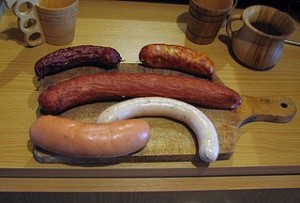
Oscypek (oh SI pek): a hard cheese, often served with a dollop of cranberry sauce. The smoked variety is the most popular.
Classic dishes
Bigos (bee GOSH): one of the national dishes of Poland. The base of this hearty hunter’s stew is cabbage (fresh or sauerkraut) and tomatoes. Depending on what’s available, the chef may add pork, bacon, sausage, duck, venison, as well as mushrooms, onions, apples, dried plums, etc. Traditional spices: bay leaf, black pepper, allspice. Can take 2-4 days to cook.
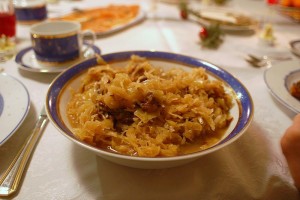
Barszcz (BOHRsht): borscht or beet soup, served hot or cold. Usually based on a meat stock. Vegetables or small pierogi may be tossed in.
Flaki (FLAH ki): thick soup with strips of tripe (cow stomach), vegetables (carrots, onions), and usually meatballs. A popular “fast” food.
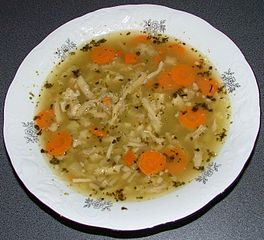
Gulasz (GOO lash): goulash, a Hungarian / Balkan import. The Polish variety features beef, red bell peppers, tomatoes, and onions, and is seasoned with paprika, garlic, chili pepper, and/or marjoram. It’s often eaten with kasza (buckwheat).
Gołąbki (go LAB ki): white cabbage leaf stuffed with rice, tomato sauce, and spiced beef and/or pork.
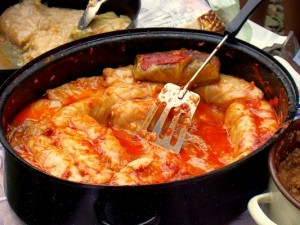
Golonka (go LON ka): melt-in-your-mouth ham hock.
Jajecznica z kurkami i boczkiem (ya yech NEET zah … oh, just point to this one!): scrambled eggs with chanterelle mushrooms, bacon, chives.
Kaszanka (kah SHAN kah): blood sausage, traditionally pig’s blood, pig offal (liver, lungs, skin, fat), and buckwheat in a sausage casing, flavored with onion, pepper, and marjoram. Usually grilled or fried, served with potato and sauerkraut.
Kopytka (koh PIT keh): potato dumplings, similar to gnocchi, often with cheese, bacon, or onion. The name, “little hooves,” is based on the shape.
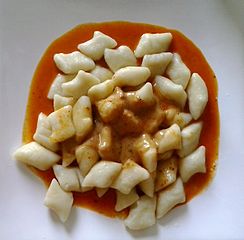
Kluski (KLOO ski): pasta. With sweet curd cheese is z serem. With strawberies or bilberries (usually with cream and sugar) is z truskawkami or jagodami.
Kotlet schabowy (KOT let skah BO ve): pork cutlet, breaded and fried (schnitzel)
Mizera (mee ZEH rah): cucumber salad with dill, similar to Greek tzatziki but with sour cream instead of yogurt
Ogorek kiszony (OH gor ek kee SHO neh): sour dill pickles
Pampuchy (pam POOH heh): steamed fluffy dumplings (i.e., leavened), plain, filled with fruit, or in meat sauce.
Pierogi (pee eh ROH gee): crescent-shaped dumplings, fried or boiled. One of the best-known Polish dishes. They can be filled with meat, fruit, cheese, potatoes, onions, cabbage, mushrooms, etc.
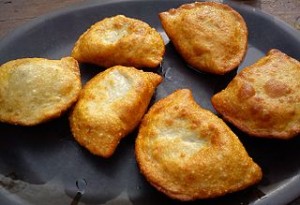
Placki ziemniaczane (PLATZ kee Zyeb nah CHAH neh): potato pancakes. Grated potatoes mixed with egg, onion, and spices; sometimes sprinkled with sugar or served with chunks of sweet curd cheese.
Pyzy (PAY zay): dumplings made from grated potatoes and stuffed with meat, then steamed and/or lightly lightly fried. Eaten as a small meal or as a side dish to a main course.
Rosół z kury (ROH sol z KOO ray): clear chicken soup, sometimes served with noodles. Adding other ingredients (a hard-boiled egg, kielbasa, carrots, potatoes) turns it into zurek, a meal in itself.
Smalec (SMALL ek): fried lard that’s served instead of butter with bread
Surówka (SOO ruv ka): shredded root vegetables with lemon and sugar or sauerkraut. Think cole slaw.
Zrazy (ZRAH zeh): a seasoned slice of beef, veal, or game, wrapped around a filling of bacon, breadcrumbs, and mushrooms, then fried or grilled.
Zupa grzybowa (ZOO pah Grzee BO vah): mushroom soup (not like Campbells!).
Desserts
Babka (BAHB ka): pound cake
Sernik (SEHR nik): a cheesecake with a cream cheese base
Pampuchy (pam POOH heh) with fruit filling
Makowiec (MAH ko vietz), a poppy-seed pastry
Drinks
Vodka: possibly invented in Poland in the Middle Ages, it’s made from rye, potatoes, or plums (sliwowica, slee vo VEETZ ah). For more, see here.
Miod pitny (MEE ohd PEET neh): mead, also dates back to the Middle Ages. The base is fermented honey; it is sometimes flavored with fruits or with spices such as cinnamon, cloves, ginger, mint, orange peel. It comes in 4 varieties of decreasing alcohol content and sweetness: poltorak, dwojniak, trojniak, czworniak.
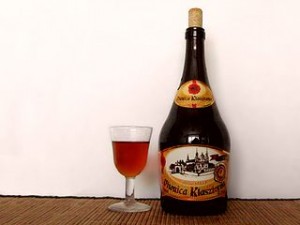
Beer: Poland has 70 breweries, with produce lager and porter. Occasionally beer is served with a shot of raspberry or blackcurrant juice. Biggest brands: Okocim, Krolewskie, Zywiec.
Nalewka (nah LEF kah): liqueurs or cordials made of fruits or spices macerated in vodka or other spirits
For the meek
Pierogi Ruskie (Ruthenian), with potatoes and cheese
For the bold
Flaki (tripe soup), kaszanka (blood sausage)
For the digestively challenged
Low carb or diabetic: any of the meat dishes, such as bigos, gulasz, gołąbki, kaszanka, kotlet schabowy
Low fat: not easy. Try barszcz, ogorek kiszony, mizera
Vegetarians: also not easy, since animal fat is widely used even on vegetables. If you don’t eat dairy or eggs, your options are very limited. Try Zupa grzybowa (mushroom soup), gołąbki (stuffed cabbage, if you can find it without meat), placki ziemniaczane (potato pancakes), pierogi with fruit or cheese filling, or kluski (pasta) topped with fruit or cheese.
More
New York’s Central Park has an over-lifesize sculpture of Jagiello, King of Poland and Grand Duke of Lithuania. Photo Copyright (c) 2015 Dianne L. Durante
